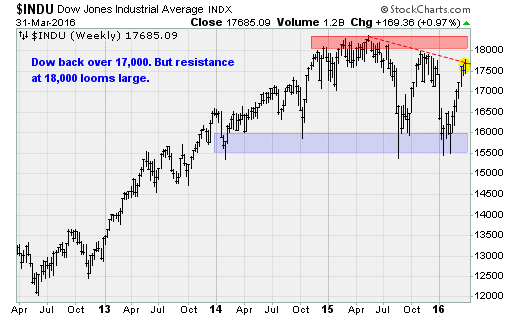After the great comeback, what's next for stocks?
Investors suffered a gut-wrenching ride in their portfolios to start 2016. But by first quarter's end, they were rewarded for their steadfastness.
While stocks finished mixed on Thursday to put an end to March and the quarter, it capped the greatest stock market comeback in history. The Dow Jones industrials index's 11.3 percent drop into the January low (with a retest in February) is the largest on record for a quarter that finished in the green. (The next closest was during the 1930s.)
Impressive stuff. But where do we go from here as stocks now struggle just below Dow 18,000 (chart below), a level that has limited upward progress since late 2014?
A hint that all is not well can be seen in the way gold was actually a first-quarter outperformer: The yellow metal, a classic safe haven asset, gained 16.1 percent for its best quarter since 1986 and its best start to a year since 1974. Treasury bonds, another safe haven, gained nearly 3 percent for the best performance since the middle of 2012.
The Dow gained 1.5 percent for the quarter. The more representative S&P 500 gained just 0.8 percent. The tech-heavy Nasdaq Composite lost 2.8 percent, while the small-cap stocks in the Russell 2000 lost 1.9 percent.
A similar story is told from sector-level performances: Defensive utility stocks led the way, while financials and health care (mainly, speculative biotechs) were slammed.
March's powerful rally had a bit of a different flavor. The S&P 500 gained nearly 7 percent for its second-best month since October 2011. Financial stocks gained 6.6 percent for their best month since March 2012. And crude oil gained 14.1 percent for its best month since late 2011.
Despite the strong showings in March, indications of weakness lie just below the surface. After one of the best rebounds in market history, the first quarter of 2016 closed with a whimper on Thursday amid lingering focus on Federal Reserve Chair Janet Yellen's dovish speech on Tuesday.
All eyes are on Friday's nonfarm payroll report for clues about the likely pace and timing of rate hikes later this year. The start of the first-quarter earnings season also kicks off soon, on April 11. As evidence of inflationary pressures builds, the Federal Reserve's economic justification for holding off on any new rate hikes is looking shaky.
No wonder, on a technical basis, stocks look so vulnerable.
You could see that in the 58 percent-plus drop in New York Stock Exchange net advancing issues during Wednesday's market advance -- to 770 issues -- from Tuesday's advance.
Another way to view this is by looking at the ratio of up volume vs. total volume on the NYSE. That ratio also dropped yesterday, by 9.2 percent, to 65 percent of total volume. Compare this to a high of 72 percent hit earlier in the week, 85 percent in early March, 90 percent in February and 92 percent in late January.
A stronger economy, lower unemployment and higher inflation might not be enough for a stock market addicted to cheap money stimulus as the Fed is forced to raise rates again -- possibly as soon as April but more likely in June. That will worsen the weak oil/strong dollar dynamic that's weighing so badly on corporate earnings.
As the calendar flips to April and the second quarter starts, we will see if the bears will emerge from a multi-month hibernation to reverse what has been a historic, uninterrupted seven-week uptrend.

